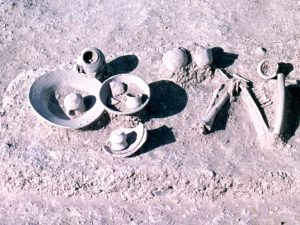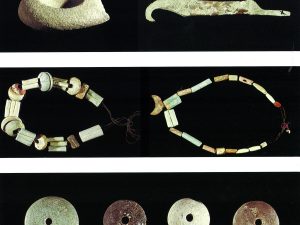Qeytariyehقیطریه
Location: The archaeological site of Qeytariyeh was located in the city of Tehran, in northern Iran, Tehran Province.
35°47’27.39″N 51°27’8.39″E
Map
Historical Period
Late Bronze Age / Eary Iron Age
History and description
Located in the northern part of the modern city of Tehran at 1700 m above sea level, Qeytariyeh consists of an extensive neighborhood of the city, which has gone through changes, city development, and building programs. The archaeological site once lay on the slope of a large hill of sandstone layers. It consisted of an extensive graveyard to the east/southeast of the present-day Qeytariyeh Park (fig. 1). The excavated surface is vast, reaching 5000 m² and yielding 350 graves and more than 2000 objects. The majority of tombs are simple pit graves (fig. 2). The scarcity or absence of iron indicates that the graveyard was in use for a period in the late second millennium B.C. (Medvedskaya, “Mogilink Kaytariyeh,” pp. 173-174; Mousavi, “La region de Téhéran,” p. 187). The excavator of the site tends to associate the majority of ceramic finds with those of the Late Bronze Age (for example, Tepe Hissar IIIC) and the Early Iron Age (such as Marlik). In fact, the ceramic record of the site suggests that the burnished grey pottery of the Early Iron Age is the direct outcome of the Bronze Age greyware, the date of which can go back as early as 1600/1500 B.C. (Kambakhsh Fard, Tehran-e sehezārodevist saleh , p. 162-163).
Archaeological Exploration
In 1969, Seyfollah Kambakhsh Fard conducted excavations at Qeytariyeh on behalf of the Iranian Department of Archaeology. In total, 158 trenches of 5m x 5m were dug in three selected zones as follows: zone a: An area located to the south of the Qeytariyeh Park which covered 1650 m², and included 66 trenches which yielded 123 tombs; zone b: An area located to the west of the preceding zone, which was an extension of the latter covering 2300m² with 92 trenches that yielded 177 tombs; zone c: An area located in the park; this included five soundings which revealed several tombs, the number and the contents of which have not been given in the publication. Other soundings were also carried out on the flanks of the hills to the north of the park, which revealed tombs of Islamic date. The excavator published two preliminary reports (Kambakhsh Fard, “Fouilles dans les tombes anciennes de Gheytariyeh”; “Gheytariyeh”). Inna Medvedskaya published a preliminary study of the findings in 1977 (Medvedskaya, “Mogilink Kaytariyeh”). The excavation results were fully published in 1990 (Kambakhsh Fard, Tehran-e sehezārodevist saleh). In 2001, the National Museum of Iran organized an exhibition of finds from his excavations in the region of Tehran, including those at Qeytariyeh (Kambakhsh Fard, A Glance at Tehran 3000 Years Ago, pp. 10-14).
Finds
The excavations yielded three categories of finds: ceramics, metal objects, bones and skeletal remains. Pottery consists of burnished grey to light grey wares of various shapes (figs. 3 and 4). Metal objects are exclusively in bronze and consist of objects of daily use with a general absence of weapons. The skeletal remains, well preserved at the time of the excavation, have never been thoroughly studied.
Bibliography
Kambakhsh Fard, S., “Fouilles dans les tombes anciennes de Gheytariyeh,” Bastan Chenassi va Honar-e Iran, No. 2, 1969, pp.58-68 (in Persian with a résumé in French).
Kambakhsh Fard, S., “Gheytariyeh, excavation report,” Iran, vol. 8, 1970, p. 180.
Kambakhsh Fard, S., Tehran-e sehezārodevist saleh bar asās-e kavoshhāy-e bāstānshenāsi, Tehran, 1370/1991.
Kambakhsh Fard, S., A Glance at Tehran 3000 Years Ago, exhibition catalogue, the National Museum of Iran, Tehran, 1380/2001, pp. 10-14
Medvedskaya, I., “Mogilink Kaytariyeh – novii namyatnik rannezheleznogo veka Irana,” Sovetskaya Arkheologiya, No. 1, 1977, pp. 169-175.
Mousavi, A. “La région de Téhéran à l’aube de l’âge du Fer: reflexions et commentaires sur les nécropoles du IIe millénaire av. J.-C.,” Iranica Antiqua, vol. 36, 2001, pp. 151-212.





































































































































